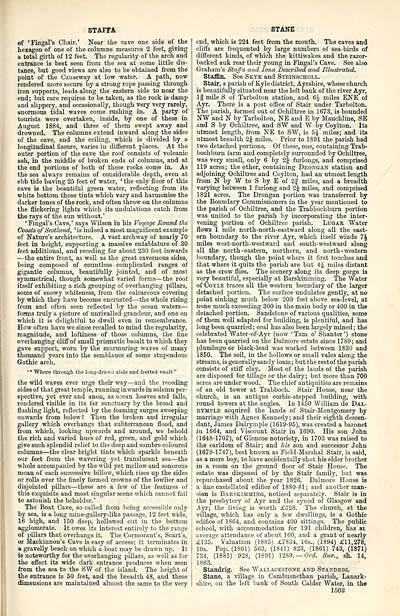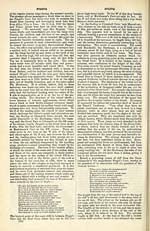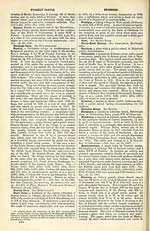Ordnance gazetteer of Scotland
(1511) Page 1503
Download files
Complete book:
Individual page:
Thumbnail gallery: Grid view | List view

STAFFA
of 'Fingal's Chair.' Near the cave one side of the
hexagon of one of the columns measures 2 feet, giving
a total girth of 12 feet. The regularity of the arch and
entrance is best seen from the sea at some little dis-
tance, but good views are also to be obtained from the
point of the Causeway at low water. A path, now
rendered more secure by a strong rope passing through
iron supports, leads along the eastern side to near the
end ; but care requires to be taken, as the rock is damp
and slippery, and occasionally, though very very rarely,
enormous tidal waves come rushing in. A party of
tourists were overtaken, inside, by one of these in
August 1884, and three of them swept away and
drowned. The columns extend inward along the sides
of the cave, and the ceiling, which is divided by a
longitudinal fissure, varies in different places. At the
outer portion of the cave the roof consists of volcanic
ash, in the middle of broken ends of columns, and at
the end portions of both of these rocks come in. As
the sea always remains of considerable depth, even at
ebb tide having 25 feet of water, ' the only floor of this
cave is the beautiful green water, reflecting from its
white bottom those tints which vary and harmonise the
darker tones of the rock, and often throw on the columns
the flickering lights which its undulations catch from
the rays of the sun without. '
' Fingal's Cave, ' says Wilson in his Voyage Sound the
Coasts of Scotland, ' is indeed a most magnificent example
of Nature's architecture. A vast archway of nearly 70
feet in height, supporting a massive entablature of 30
feet additional, and receding for about 230 feet inwards
— the entire front, as well as the great cavernous sides,
being composed of countless complicated ranges of
gigantic columns, beautifully jointed, and of most
symmetrical, though somewhat varied forms — the roof
itself exhibiting a rich grouping of overhanging pillars,
some of snowy whiteness, from the calcareous covering
by which they have become encrusted — the whole rising
from and often seen reflected by the ocean waters —
forms truly a picture of unrivalled grandeur, and one on
which it is delightful to dwell even in remembrance.
How often have we since recalled to mind the regularity,
magnitude, and loftiness of those columns, the fine
overhanging cliff of small prismatic basalt to which they
gave support, worn by the murmuring waves of many
thousand years into the semblance of some stupendous
Gothic arch,
iw Where through the long-drawn aisle and fretted vault"
the wild waves ever urge their way — and the receding
sides of that great temple, running inwards in solemn per-
spective, yet ever and anon, as ocean heaves and falls,
rendered visible in its far sanctuary by the broad and
flashing light, reflected by the foaming surges sweeping
onwards from below ! Then the broken and irregular
gallery which overhangs that subterranean flood, and
from which, looking upwards and around, we behold
the rich and varied hues of red, green, and gold which
give such splendid relief to the deep and sombre coloured
columns — the clear bright tints which sparkle beneath
our feet from the wavering yet translucent sea — the
whole accompanied by the wild yet mellow and sonorous
moan of each successive billow, which rises up the sides
or rolls over the finely formed crowns of the lowlier and
disjointed pillars — these are a few of the features of
this exquisite and most singular scene which cannot fail
to astonish the beholder.'
The Boat Cave, so called from being accessible only
by sea, is a long mine-gallery-like passage, 12 feet wide,
16 high, and 150 deep, hollowed out in the bottom
agglomerate. It owes its interest entirely to the range
of pillars that overhangs it. The Cormorant's, Scarfs,
or Mackinnon's Cave is easy of access ; it terminates in
a gravelly beach on which a boat may be drawn up. It
is noteworthy for the overhanging pillars, as well as for
the effect its wide dark entrance produces when seen
from the sea to the SW of the island. The height of
the entrance is 50 feet, and the breadth 48, and these
dimensions are maintained almost the same to the very
STANE
end, which is 224 feet from the mouth. The caves and
cliffs are frequented by large numbers of sea-birds of
different kinds, of which the kittiwakes and the razor-
backed auk rear their young in Fingal's Cave. See also
Graham's Staffa and Iona Described and Illustrated.
Staffin, See Sktb and Steinscholl.
Stair, a parish of Kyle district, Ayrshire, whose church
is beautifully situated near the left bank of the river Ayr,
1§ mile S of Tarbolton station, and 6J miles ENE of
Ayr. There is a post office of Stair under Tarbolton.
The parish, formed out of Ochiltree in 1673, is bounded
NW and N by Tarbolton, NE and E by Mauchline, SE
and S by Ochiltree, and SW and W by Coylton. Its
utmost length, from NE to SW, is 5J miles; and its
utmost breadth 2£ miles. Prior to 1891 the parish had
two detached portions. Of these, one, containing Trab-
bochburn farm and completely surrounded by Ochiltree,
was very small, only 6 by 2J furlongs, and comprised
119 acres; the other, containing Deongan station and
adjoining Ochiltree and Coylton, had an utmost length
from N by W to S by E of 2| miles, and a breadth
varying between 1 furlong and 1\ miles, and comprised
1821 acres. The Drongan portion was transferred by
the Boundary Commissioners in the year mentioned to
the parish of Ochiltree, and the Trabbochburn portion
was united to the parish by incorporating the inter-
vening portion of Ochiltree parish. Lugar Water
flows 1 mile north-north-eastward along all the east-
ern boundary to the river Ayr, which itself winds 7J
miles west-north-westward and south-westward along
all the north-eastern, northern, and north-western
boundary, though the point where it first touches and
that where it quits the parish are but 4$ miles distant
as the crow flies. The scenery along its deep gorge is
very beautiful, especially at Barskimming. The Water
of Coyle traces all the western boundary of the larger
detached portion. The surface undulates gently, at no
point sinking much below 200 feet above sea-level, at
none much exceeding 300 in the main body or 400 in the
detached portion. Sandstone of various qualities, some
of them well adapted for building, is plentiful, and has
long been quarried; coal has also been largely mined; the
celebrated Water-of-Ayr (now 'Tarn o' Shanter') stone
has been quarried on the Dalmore estate since 1789; and
plumbago or black-lead was worked between 1830 and
1850. The soil, in the hollows or small vales along the
streams, is generally sandy loam ; but the rest of the parish
consists of stiff clay. Most of the lands of the parish
are disposed for tillage or the dairy; but more than 700
acres are under wood. The chief antiquities are remains
of an old tower at Trabboch. Stair House, near the
church, is an antique corbie-stepped building, with
round towers at the angles. In 1450 William de Dal-
eymple acquired the lands of Stair-Montgomery by
marriage with Agnes Kennedy ; and their eighth descen-
dant, James Dalrymple (1619-95), was created a baronet
in 1664, and Viscount Stair in 1690. His son John
(1648-1707), of Glencoe notoriety, in 1703 was raised to
the earldom of Stair; and his son and successor John
(1679-1747), best known as Field-Marshal Stair, is said,
as a mere boy, to have accidentally shot his elder brother
in a room on the ground floor of Stair House. The
estate was disposed of by the Stair family, but was
repurchased about the year 1826. Dalmore House is
a fine castellated edifice of 1880-S1; and another man-
sion is Barskimming, noticed separately. Stair is in
the presbytery of Ayr and the synod of Glasgow and
Ayr; the living is worth £328. The church, at the
village, which has only a few dwellings, is a Gothic
edifice of 1864, and contains 400 sittings. The public
school, with accommodation for 191 children, has ai
average attendance of about 160, and a grant of nearly
£135. Valuation (1885) £7834, 16s., (1894) £11,278,
10s. Pop. (1801) 563, (1841) 823, (1861) 743, (1871)
734, (1881) 928, (1891) 1289. — Ore?. Sur., sh. 14,
1863.
Standrig. See Wallacestone and Standeig.
Stane, a village in Cambusnethan parish, Lanark-
shire, on the left bank of South Calder Water, in the
1503
of 'Fingal's Chair.' Near the cave one side of the
hexagon of one of the columns measures 2 feet, giving
a total girth of 12 feet. The regularity of the arch and
entrance is best seen from the sea at some little dis-
tance, but good views are also to be obtained from the
point of the Causeway at low water. A path, now
rendered more secure by a strong rope passing through
iron supports, leads along the eastern side to near the
end ; but care requires to be taken, as the rock is damp
and slippery, and occasionally, though very very rarely,
enormous tidal waves come rushing in. A party of
tourists were overtaken, inside, by one of these in
August 1884, and three of them swept away and
drowned. The columns extend inward along the sides
of the cave, and the ceiling, which is divided by a
longitudinal fissure, varies in different places. At the
outer portion of the cave the roof consists of volcanic
ash, in the middle of broken ends of columns, and at
the end portions of both of these rocks come in. As
the sea always remains of considerable depth, even at
ebb tide having 25 feet of water, ' the only floor of this
cave is the beautiful green water, reflecting from its
white bottom those tints which vary and harmonise the
darker tones of the rock, and often throw on the columns
the flickering lights which its undulations catch from
the rays of the sun without. '
' Fingal's Cave, ' says Wilson in his Voyage Sound the
Coasts of Scotland, ' is indeed a most magnificent example
of Nature's architecture. A vast archway of nearly 70
feet in height, supporting a massive entablature of 30
feet additional, and receding for about 230 feet inwards
— the entire front, as well as the great cavernous sides,
being composed of countless complicated ranges of
gigantic columns, beautifully jointed, and of most
symmetrical, though somewhat varied forms — the roof
itself exhibiting a rich grouping of overhanging pillars,
some of snowy whiteness, from the calcareous covering
by which they have become encrusted — the whole rising
from and often seen reflected by the ocean waters —
forms truly a picture of unrivalled grandeur, and one on
which it is delightful to dwell even in remembrance.
How often have we since recalled to mind the regularity,
magnitude, and loftiness of those columns, the fine
overhanging cliff of small prismatic basalt to which they
gave support, worn by the murmuring waves of many
thousand years into the semblance of some stupendous
Gothic arch,
iw Where through the long-drawn aisle and fretted vault"
the wild waves ever urge their way — and the receding
sides of that great temple, running inwards in solemn per-
spective, yet ever and anon, as ocean heaves and falls,
rendered visible in its far sanctuary by the broad and
flashing light, reflected by the foaming surges sweeping
onwards from below ! Then the broken and irregular
gallery which overhangs that subterranean flood, and
from which, looking upwards and around, we behold
the rich and varied hues of red, green, and gold which
give such splendid relief to the deep and sombre coloured
columns — the clear bright tints which sparkle beneath
our feet from the wavering yet translucent sea — the
whole accompanied by the wild yet mellow and sonorous
moan of each successive billow, which rises up the sides
or rolls over the finely formed crowns of the lowlier and
disjointed pillars — these are a few of the features of
this exquisite and most singular scene which cannot fail
to astonish the beholder.'
The Boat Cave, so called from being accessible only
by sea, is a long mine-gallery-like passage, 12 feet wide,
16 high, and 150 deep, hollowed out in the bottom
agglomerate. It owes its interest entirely to the range
of pillars that overhangs it. The Cormorant's, Scarfs,
or Mackinnon's Cave is easy of access ; it terminates in
a gravelly beach on which a boat may be drawn up. It
is noteworthy for the overhanging pillars, as well as for
the effect its wide dark entrance produces when seen
from the sea to the SW of the island. The height of
the entrance is 50 feet, and the breadth 48, and these
dimensions are maintained almost the same to the very
STANE
end, which is 224 feet from the mouth. The caves and
cliffs are frequented by large numbers of sea-birds of
different kinds, of which the kittiwakes and the razor-
backed auk rear their young in Fingal's Cave. See also
Graham's Staffa and Iona Described and Illustrated.
Staffin, See Sktb and Steinscholl.
Stair, a parish of Kyle district, Ayrshire, whose church
is beautifully situated near the left bank of the river Ayr,
1§ mile S of Tarbolton station, and 6J miles ENE of
Ayr. There is a post office of Stair under Tarbolton.
The parish, formed out of Ochiltree in 1673, is bounded
NW and N by Tarbolton, NE and E by Mauchline, SE
and S by Ochiltree, and SW and W by Coylton. Its
utmost length, from NE to SW, is 5J miles; and its
utmost breadth 2£ miles. Prior to 1891 the parish had
two detached portions. Of these, one, containing Trab-
bochburn farm and completely surrounded by Ochiltree,
was very small, only 6 by 2J furlongs, and comprised
119 acres; the other, containing Deongan station and
adjoining Ochiltree and Coylton, had an utmost length
from N by W to S by E of 2| miles, and a breadth
varying between 1 furlong and 1\ miles, and comprised
1821 acres. The Drongan portion was transferred by
the Boundary Commissioners in the year mentioned to
the parish of Ochiltree, and the Trabbochburn portion
was united to the parish by incorporating the inter-
vening portion of Ochiltree parish. Lugar Water
flows 1 mile north-north-eastward along all the east-
ern boundary to the river Ayr, which itself winds 7J
miles west-north-westward and south-westward along
all the north-eastern, northern, and north-western
boundary, though the point where it first touches and
that where it quits the parish are but 4$ miles distant
as the crow flies. The scenery along its deep gorge is
very beautiful, especially at Barskimming. The Water
of Coyle traces all the western boundary of the larger
detached portion. The surface undulates gently, at no
point sinking much below 200 feet above sea-level, at
none much exceeding 300 in the main body or 400 in the
detached portion. Sandstone of various qualities, some
of them well adapted for building, is plentiful, and has
long been quarried; coal has also been largely mined; the
celebrated Water-of-Ayr (now 'Tarn o' Shanter') stone
has been quarried on the Dalmore estate since 1789; and
plumbago or black-lead was worked between 1830 and
1850. The soil, in the hollows or small vales along the
streams, is generally sandy loam ; but the rest of the parish
consists of stiff clay. Most of the lands of the parish
are disposed for tillage or the dairy; but more than 700
acres are under wood. The chief antiquities are remains
of an old tower at Trabboch. Stair House, near the
church, is an antique corbie-stepped building, with
round towers at the angles. In 1450 William de Dal-
eymple acquired the lands of Stair-Montgomery by
marriage with Agnes Kennedy ; and their eighth descen-
dant, James Dalrymple (1619-95), was created a baronet
in 1664, and Viscount Stair in 1690. His son John
(1648-1707), of Glencoe notoriety, in 1703 was raised to
the earldom of Stair; and his son and successor John
(1679-1747), best known as Field-Marshal Stair, is said,
as a mere boy, to have accidentally shot his elder brother
in a room on the ground floor of Stair House. The
estate was disposed of by the Stair family, but was
repurchased about the year 1826. Dalmore House is
a fine castellated edifice of 1880-S1; and another man-
sion is Barskimming, noticed separately. Stair is in
the presbytery of Ayr and the synod of Glasgow and
Ayr; the living is worth £328. The church, at the
village, which has only a few dwellings, is a Gothic
edifice of 1864, and contains 400 sittings. The public
school, with accommodation for 191 children, has ai
average attendance of about 160, and a grant of nearly
£135. Valuation (1885) £7834, 16s., (1894) £11,278,
10s. Pop. (1801) 563, (1841) 823, (1861) 743, (1871)
734, (1881) 928, (1891) 1289. — Ore?. Sur., sh. 14,
1863.
Standrig. See Wallacestone and Standeig.
Stane, a village in Cambusnethan parish, Lanark-
shire, on the left bank of South Calder Water, in the
1503
Set display mode to: Large image | Transcription
Images and transcriptions on this page, including medium image downloads, may be used under the Creative Commons Attribution 4.0 International Licence unless otherwise stated. ![]()
| Gazetteers of Scotland, 1803-1901 > Ordnance gazetteer of Scotland > (1511) Page 1503 |
|---|
| Permanent URL | https://digital.nls.uk/97411378 |
|---|

